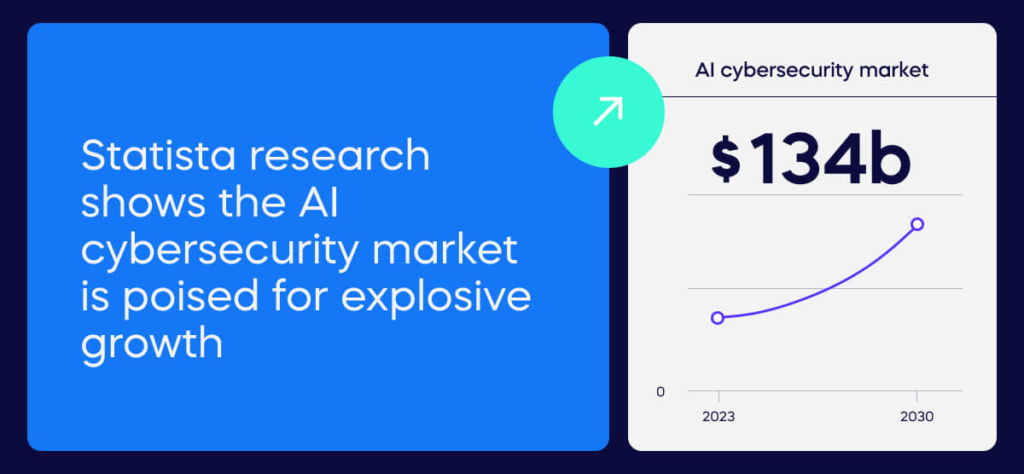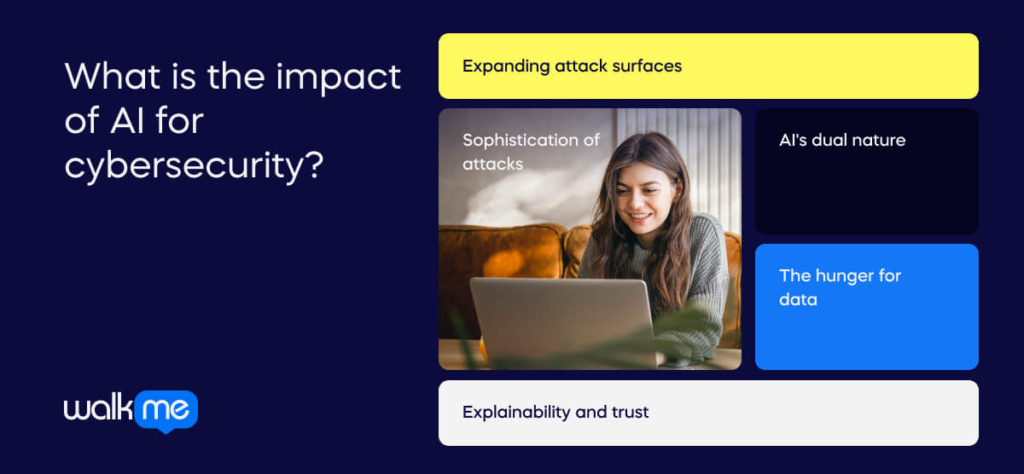Artificial intelligence (AI) developments have come a long way since computer scientist Alan Mathison Turing pioneered the field. With its potential once relegated to the pages of far-flung sci-fi novels, AI has since become a very real and powerful force.
The latest advances in AI have catapulted its capabilities to new heights. AI can now perform creative tasks, solve complex problems, and mimic physical interaction as humans can.
One area where AI is proving transformative is cybersecurity. Developers have long leveraged AI-driven cybersecurity practices to protect their systems.
Machine learning (ML) is a great example. These algorithms are trained to enhance anomaly detection across network security. This has helped businesses pinpoint and safeguard against malware, fraud, and phishing attacks.
This article will explore everything you need to know about AI for cybersecurity, including what it is, how it works, and its impact on the cybersecurity industry. It will also include use cases, best practices, benefits, and challenges.
What is artificial intelligence (AI) for cybersecurity?
Artificial intelligence (AI) teaches computers to emulate intelligent actions with minimal human involvement.
Cybersecurity is about ensuring the safety and security of computer systems from start to finish. This includes building a robust IT infrastructure to mitigate systems, networks, and data threats.
Statista research shows the AI cybersecurity market is poised for explosive growth. Projections estimate it will surge from $24 billion in 2023 to $134 billion by 2030.

Today, traditional cybersecurity practices combine with the latest AI solutions to elevate the security posture of IT systems to levels previously unheard of.
AI for cybersecurity uses artificial intelligence to detect, assess, and mitigate cyber threats. AI often employs machine learning (ML) algorithms and natural language processing (NLP) techniques. These help to identify and flag patterns and anomalies pointing to malicious activity.
How does AI for cybersecurity work?
As we know, AI cybersecurity today relies on a combination of techniques to defend against cyber threats. It involves training machines to learn, analyze, and automate cybersecurity-related tasks.
To better understand how AI cybersecurity functions, let’s break down the key components:
- Artificial intelligence (AI) involves various techniques that enable machines to mimic human intelligence. In cybersecurity, AI can include:
- Machine learning (ML) algorithms use data to identify patterns and make predictions. They are used for anomaly detection, threat analysis, and phishing email identification.
- Deep learning is a type of ML that uses complex neural networks for tasks like image and voice recognition. It can also detect malware based on code patterns.
- Natural language processing (NLP) enables machines to understand and process human language. They are used to analyze security logs and identify potential breaches.
For cybersecurity professionals, AI presents a new arena of potential. Solutions are being devised to address a diverse array of security challenges.
For example, Generative Adversarial Networks (GANs) strengthen cybersecurity practices on an enterprise scale. They can create realistic faux cyberattack scenarios with dummy data, networks, and systems.
This allows cybersecurity technicians to test their security parameters and isolate vulnerabilities. AI also enhances phishing detection by analyzing patterns in sender operations email communication.
Elsewhere, strides in explainable AI (XAI) and the increasing availability of open-source tools are fueling the ethical development of AI.
It’s clear that as AI advances, its role in cybersecurity will only become more integrated. In time, it will provide more effective and targeted solutions for protecting vulnerable IT systems.
What is the impact of AI for cybersecurity?

We’ve explored how AI plays a transformative role in cybersecurity. The challenge is clear: attacks are growing in number and complexity.
Now, let’s explore how AI can both positively and negatively impact cybersecurity.
Expanding attack surfaces
The growth of interconnected devices, cloud services, and IoT creates an expanding attack surface. This presents a major challenge for cybersecurity. AI must constantly monitor massive networks for subtle irregularities. AI’s task is to sift through immense data flows and search for faint signals that might betray a malicious intrusion attempt.
Sophistication of attacks
AI empowers cybercriminals to craft alarmingly sophisticated attacks. Phishing emails can now be tailored with precision thanks to AI-powered language generation. Malware can be programmed to learn, adapt, and disguise its presence within normal system activity. This prolongs its infiltration and evades conventional security measures.
AI’s dual nature
Artificial intelligence is a potent weapon in the ongoing battle for cybersecurity. Cybersecurity teams leverage AI to analyze immense datasets in real-time. They detect patterns that could signal an intrusion. AI systems scan for vulnerabilities, suggest fixes, and even automate initial breach responses.
The hunger for data
The effectiveness of AI in cybersecurity relies on access to vast datasets of threat intelligence. Machine learning models require diverse and meticulously labeled examples of attacks to hone their detection abilities. This constant supply of data allows AI systems to evolve alongside the threat landscape and ensure they remain vigilant.
Explainability and trust
The complexity of some AI models can obscure their decision-making processes. In the high-stakes world of cybersecurity, trust in defensive systems is paramount. Efforts to enhance AI explainability allow for thorough analysis when breaches occur and create confidence in AI as a crucial line of defense.
What are some AI cybersecurity use cases?
AI plays an increasingly integral role in cybersecurity. Growing adoption is transforming how organizations protect themselves from cyberattacks.
Let’s explore how AI enhances cybersecurity across several key areas:
Cloud security
AI acts as a powerful security analyst for cloud environments. It sifts through data to identify configuration errors, unusual user behavior, and security vulnerabilities. AI pinpoints weaknesses, suggests solutions, and automates repetitive security tasks. This eases the burden on teams and strengthens defenses within the cloud.
Incident investigation and response
During a cyberattack, every second is critical. AI empowers investigators by rapidly analyzing system logs and network traffic. It pinpoints the attack’s origin, determines its scope, and may even expose the attackers’ tactics. This accelerated analysis gives investigators vital insights, allowing them to respond effectively.
Endpoint security and management
AI provides robust protection for endpoints like laptops, desktops, and smartphones. It monitors device behavior for subtle anomalies that reveal malware trying to hide. AI also automates the application of software updates and patches, ensuring that endpoints are fortified against the latest known vulnerabilities.
Cyberthreat detection
AI can assess and analyze network data for any signs of a cyber breach. By learning to recognize normal traffic patterns, it can flag deviations that could signal a breach. This includes threats that don’t resemble known malware signatures, giving defenders an edge.
Identity and access management (IAM)
AI revolutionizes how we manage sensitive data access. It analyzes typical user behavior patterns to spot red flags. These can be things like login attempts from unusual locations or efforts to access data that doesn’t align with a user’s role. AI then triggers additional security measures and blocks potentially compromised accounts. It can even alert security teams, preventing unauthorized access.
Data protection
AI assists organizations in identifying and classifying sensitive data. It scans files, emails, and databases to locate credit card numbers, personally identifiable information (PII), or other confidential material. Once identified, AI helps enforce the necessary security controls. It does this by alerting teams to data leaks and safeguarding critical assets.
What are the benefits AI for cybersecurity?
As cyber threats become more sophisticated, it’s crucial to understand how AI can transform cybersecurity.
Here are some key benefits:
Proactive threat detection
AI’s data assessment capabilities are ideal for overseeing cybersecurity. Powerful AI algorithms identify subtle patterns or anomalies that might signal a breach, even if the threat doesn’t match a known malware signature. This gives defenders a head start in stopping attacks early.
Reduced workload for security teams
AI automates many time-consuming and repetitive tasks. These include analyzing logs or triaging alerts. This frees up security professionals to focus on complex investigations and strategic initiatives.
Improved vulnerability management
AI can scan systems for misconfigurations, outdated software, and vulnerabilities. It then recommends solutions, helping organizations reduce their attack surface and stay ahead of threats.
Enhanced incident response
During a breach, AI assists with rapid analysis of attack origins, scope, and methods. It provides a clearer picture of the situation, enabling security teams to respond and minimize damage.
Adaptability to evolving threats
AI systems learn and improve based on new data and attack patterns. This allows them to adapt to the ever-changing threat landscape, ensuring robust defenses.
What are the challenges of AI for cybersecurity?
Successful deployment of AI in cybersecurity requires more than just understanding the benefits.
Here are some critical challenges:
Data quality and bias
AI models are only as good as the data they’re trained on. Incomplete, inaccurate, or biased data can severely affect their performance. Biased data may lead to AI systems that perpetuate unfair treatment or discrimination. Ensuring high-quality, diverse, and curated datasets is crucial for reliable and equitable AI applications in cybersecurity.
Lack of explainability
Many AI models operate with limited transparency. This “black box” nature makes it difficult to understand how they arrive at decisions or identify the reason behind a specific alert. Explainability is vital for building trust in AI-powered defenses. It helps troubleshoot issues and refine models over time.
Adversarial attacks
Cybercriminals can manipulate the data an AI system learns from or exploit vulnerabilities within the model itself. These adversarial attacks may lead to AI misclassifying threats. This allows attackers to evade detection or cause the system to make harmful decisions.
Skills gap
Developing and managing AI for cybersecurity requires specialized expertise. Studying in areas like data science, machine learning, and security engineering is useful. Many organizations face a shortage of talent in these domains. This can create challenges in selecting and customizing the right AI solutions for specific needs.
Cost and complexity
AI solutions often have upfront investment costs for software, hardware, and specialized personnel. They may also introduce complexity into existing security systems. This requires careful integration and ongoing management. Organizations must assess the ROI of implementing AI and ensure they have the necessary resources.
AI for cybersecurity best practices
McKinsey’s research reveals that “just 21 percent of respondents reporting AI adoption say their organizations have established policies governing employees’ use of gen AI technologies in their work.” As such, strategic implementation and thoughtful management are key to the success of AI in cybersecurity.
Here are some best practices to get you started:
Planning
A successful AI implementation in cybersecurity begins with meticulous planning. Thoroughly analyze your organization’s specific security challenges: Do you need faster threat detection? Have you improved incident response? Do you want to enhance identity protection? Choose AI solutions that align directly with these priorities. Develop a detailed roadmap outlining how AI will integrate with your existing systems. Remember to ensure compatibility and avoid potential disruption.
Integration
AI’s power in cybersecurity is amplified when it has a view of your digital environment. Prioritize solutions that integrate with your firewalls, network monitoring tools, and other systems. This consolidated data stream gives AI the rich context to detect subtle anomalies. It can also correlate disparate events and identify threats that might otherwise slip through the cracks.
Data management
The accuracy and integrity of the data used to train your AI models are paramount. Establish rigorous processes for data cleansing, ensuring it’s free from errors and inconsistencies. Implement robust privacy controls, anonymizing sensitive information where necessary. Remember, flawed or biased data will lead to unreliable AI insights. These can create false positives or even undermine your security posture.
Testing
AI models, like the threat landscape, are constantly evolving. Implement a regular testing schedule for your AI-powered security systems. Utilize simulated attacks, red team exercises, or introduce new datasets to evaluate performance. A proactive approach helps uncover biases or blind spots that may emerge over time. This allows you to continually refine and strengthen your AI defenses.
Ethical use
Recognize that AI can inherit biases present in the data it’s trained on. Avoid treating AI outputs as infallible, especially in situations with potential ethical implications. Use AI to augment human judgment and expertise. This ensures a balanced approach to decision-making in critical cybersecurity scenarios. Develop safeguards and oversight mechanisms to mitigate risks associated with AI bias and unfair treatment.
Generative AI policy
The rapid growth of generative AI brings exciting possibilities and unique challenges. Create a comprehensive policy governing their use within your organization. Address issues like deepfakes, the potential for misinformation, the ethical boundaries for content generation, and safeguards against the development of malicious tools.
The future of AI for cybersecurity
The future of cybersecurity is intertwined with AI. In the years ahead, AI will become even better at spotting threats and minimizing the noise for security teams.
It will automate many repetitive tasks, allowing experts to focus on tactical and strategic thinking. AI will also play a vital role in finding vulnerabilities and suggesting fixes, helping organizations stay a step ahead.
Despite this progress, skilled cybersecurity professionals will remain in high demand. While AI can handle the basics, human expertise is needed for complex incidents and proactive threat hunting. The ability to analyze AI outputs and make critical decisions will be crucial.
But remember, AI isn’t just a tool for the good guys. Attackers will use it to crack passwords, design convincing phishing attacks, and create security breaches. This means the race is on.
Organizations must invest in AI-powered defenses to outsmart increasingly sophisticated threats. Mastering AI will be the key to protecting our data and systems in the coming digital age.


